

Home
About Us
Allotments
Garden Equipment
Seed Suppliers
Manure Problems
Solve It - Puzzles
Children's Pages
GLA Blog
Weather Blog
School Veg Patch
Useful Links
Weather Blog
Garden Video Blog
Cold Frames and Cloches
** This website is not a shop and doesn’t sell anything! **
Be aware that any external links may contain cookies and you should refer to the particular website's cookie policy
Cold Frames
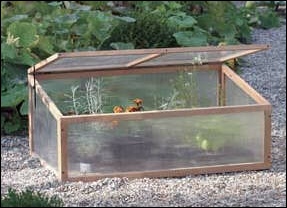 The use of cold frames and cloches can extend the growing season. Greenhouse raised plants need a period of hardening off to acclimatise them before planting outdoors and subjecting to the vagaries of outdoor life.
The use of cold frames and cloches can extend the growing season. Greenhouse raised plants need a period of hardening off to acclimatise them before planting outdoors and subjecting to the vagaries of outdoor life.
The first stage in the process of hardening off is to move plants from a greenhouse to a cold frame.
For those who haven’t the luxury of a greenhouse, a cold frame or cloche can provide some of the benefits for far less expense.
For instance salad crops and tender plants such as tomatoes and peppers can be given extra protection when growing early in the season.

Not only do cold frames and cloches protect from the weather and raise the air temperature inside but they can also raise the soil temperature and add to the level of humidity.
Conditions within a cold frame or under a cloche are often more constant than the conditions outside where plants may be subjected to buffeting and drying winds.
The difference between the temperature during the day and at night is lessened, especially if a covering of some sort is placed over the cold frame at night.
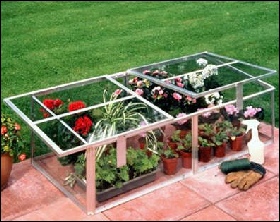
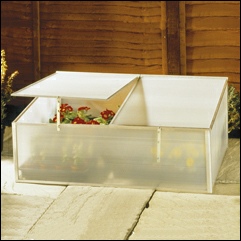 Plants growing in pots can be given temporary protection in a cold frame but if the cold frame is placed directly onto the soil crops can be planted inside the cold frame and given a good start in life. If you want to plant taller plants such as tomatoes inside a cold frame them you will need to choose a frame with a lid which can be removed once the plants grow too tall to be contained.
Plants growing in pots can be given temporary protection in a cold frame but if the cold frame is placed directly onto the soil crops can be planted inside the cold frame and given a good start in life. If you want to plant taller plants such as tomatoes inside a cold frame them you will need to choose a frame with a lid which can be removed once the plants grow too tall to be contained.
Where plants are grown directly in the soil, care needs to be taken to maintain fertility. If necessary a topless cold frame can then be netted to protect against some pests. Alternatively the cold frame can be moved around the garden or plot during subsequent seasons this allowing crop rotation.

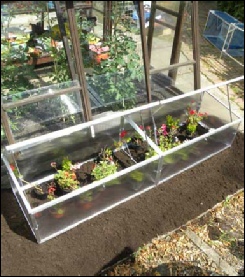 On warm sunny days the cold frame needs to be be opened to allow air to circulate and avoid fungal disease., It may be possible, depending upon the design of the cold frame, to remove the top completely or at least remove the glass in the ‘roof’. This will offer protection from prevailing winds but allow for ventilation. The top can then be replaced during periods of heavy rain to protect the plants from a battering.
On warm sunny days the cold frame needs to be be opened to allow air to circulate and avoid fungal disease., It may be possible, depending upon the design of the cold frame, to remove the top completely or at least remove the glass in the ‘roof’. This will offer protection from prevailing winds but allow for ventilation. The top can then be replaced during periods of heavy rain to protect the plants from a battering.
The glazing can be either glass or polycarbonate - both have advantages and disadvantages.
You can of course make your own cold frame but if you prefer you could browse what is available using the links on this page.
Cloches
Unlike a cold frame cloches are really meant to be moved around the garden as the need arises to give a bit of extra protection to plants that need it.
They come in a very wide range of sizes, shapes and materials. Some are very decorative and more suited to gardens where appearance matters and others are simple and purely functional.
There are cloches designed to cover individual plants and cloches designed to cover a rows or group of plants.
The queen of cloches is probably the Victorian cloche – a square based cloche which is very ornamental but also expensive.
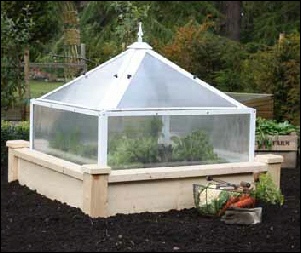

A cheaper alternative to the Victorian cloche is the bell cloche which is dome shaped design in either glass or plastic.
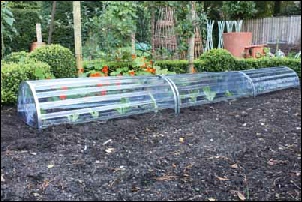
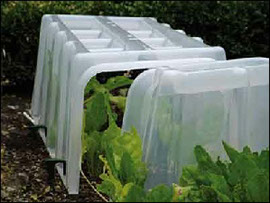
Tunnel cloches come in various lengths and are designed to be used either individually or joined together to cover a row of plants. They are not generally as attractive to look at and are usually used in a vegetable garden.
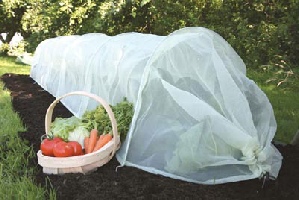
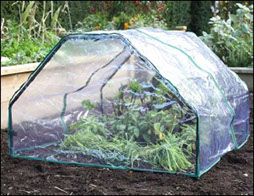
There is also something called a floating cloche which really isn’t a cloche at all – it’s a sheet of fleece or enviromesh just placed over the plants. The material is light and laid loosely over young plants or seedlings and fastened at ground level. This enables it to float up as the plants grow
As well as being used as plant protection garden cloches can be used to warm up the soil prior to planting.
Images taken from Harrod Horticultural - Cold frames and cloches
Greenfingers Garden cloches, cold frames and polytunnels
I’ve gathered together some links from companies offering gardening products for sale. I have no connection to the suppliers and therefore cannot be held responsible for any changes in items available or any issues that may arise when making a purchase.
Some companies give me a small commission on sales that are generated from this website which helps me to maintain this and sister websites but this in no way means that I am recommending purchases from a particular company.
Our Plot at Green Lane Allotments Blog | A Gardener's Weather Diary | School Vegetable Patch Website
© Our Plot on Green Lane Allotments - Please email me if you wish to use any of this site's content